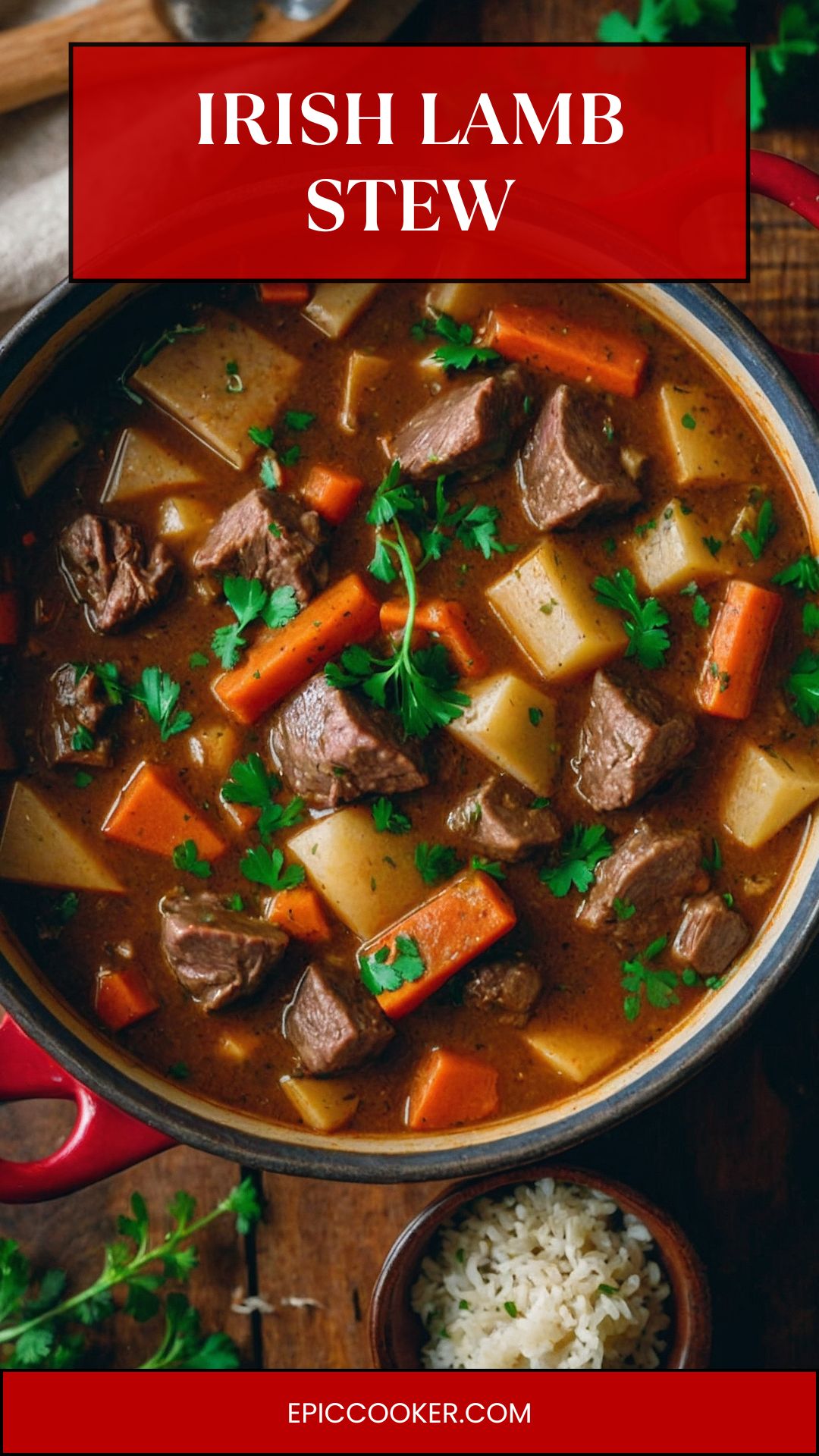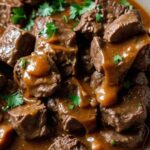Before we dive into the hearty goodness of Irish Lamb Stew, let’s explore some delightful pairings that will enhance your meal experience. Picture this: a cozy evening with a warm bowl of stew in hand. To complement this rich dish, consider serving it with a crusty loaf of Irish soda bread. This bread, with its tender crumb and golden crust, is perfect for soaking up every last drop of that savory stew.
For dessert, a slice of homemade apple tart fits beautifully after a hearty dinner. Its sweetness adds a nice contrast to the steady ration of flavors from the stew. Pairing the meal with a refreshing side salad can introduce a crisp freshness that balances the dish’s heft. A light arugula salad with lemon vinaigrette? Yes, please!
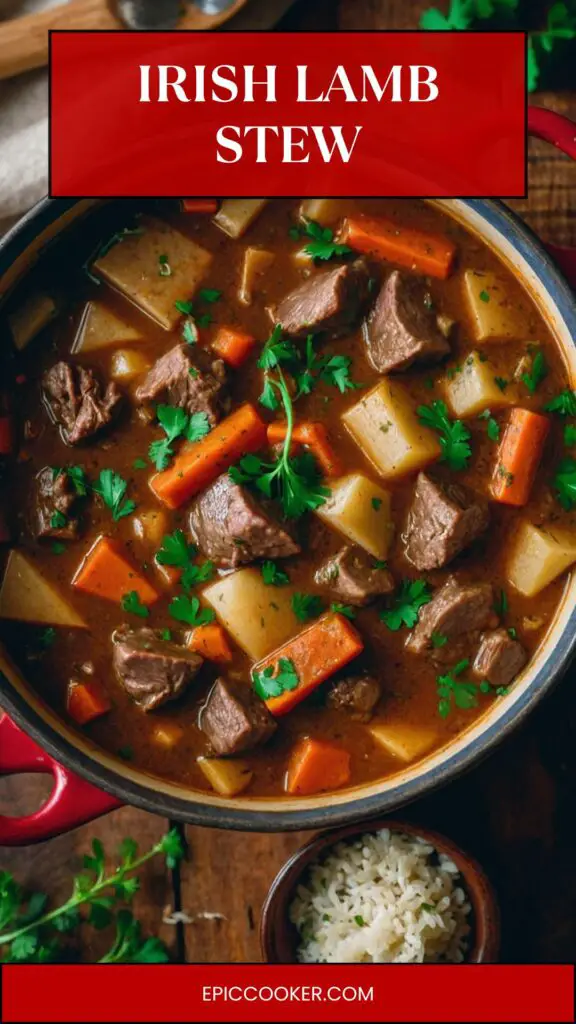
Rediscovering Irish Lamb Stew
Now, let’s talk about why Irish Lamb Stew warms my heart. In my kitchen, this recipe has become a staple during the colder months, reminiscent of cozy dinners shared with family. There’s something about the blend of tender lamb, earthy vegetables, and rich broth that just feels right.
I’ve tinkered with this recipe over the years, infusing it with my love for both tradition and flavorful twists. Sometimes, experimenting in the kitchen leads to the best discoveries. I’ve learned how to bring out the lamb’s natural flavors, and I want to share this journey with you.
This isn’t just another dish; it’s a celebration of simple, wholesome ingredients coming together to create something truly comforting. Plus, it’s one of those recipes that fills your home with appetizing aromas that beckon hungry mouths from near and far.
You will also like the following Lunch recipes!
Ingredients for Irish Lamb Stew
Here’s a list of what you’ll need to create this comforting stew:
- 2 tablespoons neutral cooking oil, divided
- 2 tablespoons of plain all-purpose flour
- 2 pounds of lamb shoulder, cut into 1½-inch chunks
- 3 garlic cloves, minced
- 1 tablespoon tomato paste
- 1 large yellow onion, thinly sliced
- Sea salt and freshly ground black pepper, to season
- 2 tablespoons of unsalted butter
- 4 cups of beef stock
- 1 bottle of Guinness stout (11.2 ounces)
- 2 sprigs of fresh thyme (or ½ teaspoon dried thyme leaves)
- 2 large russet potatoes (about 1½ pounds), peeled and roughly chopped
- 3 carrots, cut into 3-inch sections
- 2 bay leaves, whole
- ¼ cup fresh parsley, finely chopped
These ingredients create a delightful balance of flavors and textures. Each component plays its part, contributing to the overall experience you’ll share with your loved ones.
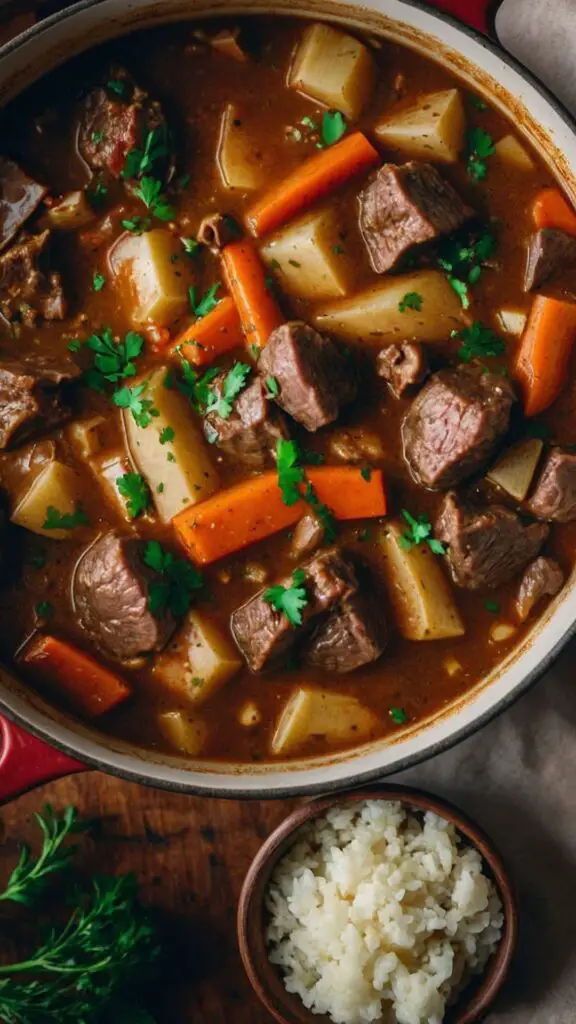
How to Make Irish Lamb Stew
Step 1: Brown the Lamb
Start by heating one tablespoon of cooking oil in a large Dutch oven over medium-high heat. While the oil warms, sprinkle the lamb chunks with salt and pepper. Once the oil shimmers, add half the lamb to the pot in a single layer. Let it brown on all sides, which should take about 5-7 minutes. Once browned, remove the lamb from the pot and set it aside. Repeat with the remaining lamb, adding more oil if necessary.
Step 2: Sauté Vegetables
After the lamb has taken a brief vacation on the sidelines, it’s time to work on the vegetables. In the same pot, add the butter and onions. Sauté them over medium heat until they soften, about 5 minutes. I adore how the onions start to turn golden and create a base of flavor. Add the garlic, cooking for another minute until fragrant. Toss in the flour and stir well, letting it cook briefly. This small step thickens the stew wonderfully!
Step 3: Build the Flavor
Next up, we need the bulldog of flavor: Guinness stout! Pour in the stout, scraping the bottom of the pot to release all those tasty brown bits. Add the tomato paste, stirring to combine before returning the browned lamb to the pot. Bring everything to a simmer and let it bubble away for about 2 minutes.
Step 4: Add Stock and Herbs
Now, pour in the beef stock, ensuring that the lamb is submerged. Toss in the thyme, bay leaves, potatoes, and carrots. Give everything a good stir to distribute the ingredients evenly.
Step 5: Simmer the Stew
Bring your stew to a boil over medium-high heat. Once it reaches a rolling boil, reduce the heat to low and cover it. Let it simmer gently for 1.5 to 2 hours. During this time, the lamb will become tender and the flavors will meld. A watch pot may not boil, but a simmering pot of stew? That’s where the magic happens.
Step 6: Finish and Serve
With the stew cooked to perfection, it’s time to remove the bay leaves and thyme. Adjust the seasoning if needed. Serve the stew hot, garnished with freshly chopped parsley. A sprinkle of salt and pepper can elevate the flavors even more. Enjoy every delectable bite!
Recipe Notes
Lamb Shoulder
Lamb shoulder is recommended for this recipe because of its fantastic flavor and ability to remain tender during long cooking. The fat content in lamb shoulder keeps the meat juicy and rich.
Beef Stock
Using good-quality beef stock enhances the overall flavor of the dish. Homemade stock is wonderful, but store-bought can save time and still provide great taste.
Guinness Stout
The stout not only adds depth but also richness. The maltiness of Guinness complements the lamb well, creating a hearty, comforting flavor profile.
Thyme
Fresh herbs like thyme provide a vibrant flavor. If dried thyme is your only option, feel free to use it, just remember it’s more potent. Dried thyme is less robust compared to fresh, so use only half.
Nutrition Information
Veggie Variations
You can mix in other vegetables like parsnips or turnips for different flavors. Feel free to get creative based on what’s in season or what you have on hand.

Recipe Variations
- Spicy Kick: Add crushed red pepper flakes for a spicy kick that pairs well with the stew’s richness.
- Herb Garden: Experiment with rosemary or bay leaves for a twist on the traditional flavor profile.
- Vegetable-Forward: For a vegetarian approach, replace lamb with hearty mushrooms like portobello or use lentils for added protein.
- Creamy Version: Add a touch of cream toward the end of cooking for a creamy texture.
- Gluten-Free: Substitute cornstarch for flour to thicken the stew, and ensure your stock is gluten-free.
- Slow Cooker: You can adapt this recipe to a slow cooker—just brown the meat first, then transfer everything to the crockpot.
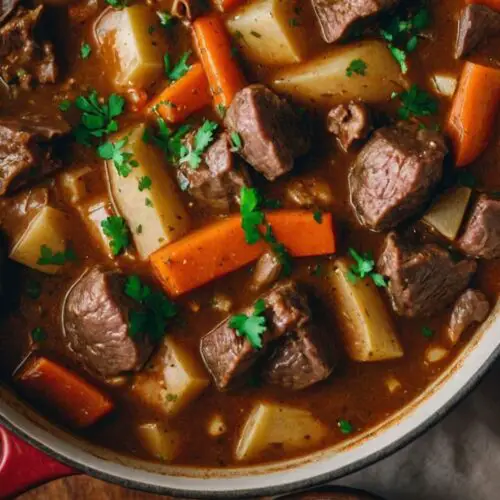
Irish Lamb Stew Recipe
Equipment
- A large dutch oven
Ingredients
- 2 tablespoons neutral cooking oil divided
- 2 tablespoons of plain all-purpose flour
- 2 pounds of lamb shoulder cut into 1½-inch chunks
- 3 garlic cloves minced
- 1 tablespoon tomato paste
- 1 large yellow onion thinly sliced
- Sea salt and freshly ground black pepper to season
- 2 tablespoons of unsalted butter
- 4 cups of beef stock
- 1 bottle of Guinness stout 11.2 ounces
- 2 sprigs of fresh thyme or ½ teaspoon dried thyme leaves
- 2 large russet potatoes about 1½ pounds, peeled and roughly chopped
- 3 carrots cut into 3-inch sections
- 2 bay leaves whole
- ¼ cup fresh parsley finely chopped
Instructions
Step 1: Brown the Lamb
- Start by heating one tablespoon of cooking oil in a large Dutch oven over medium-high heat. While the oil warms, sprinkle the lamb chunks with salt and pepper. Once the oil shimmers, add half the lamb to the pot in a single layer. Let it brown on all sides, which should take about 5-7 minutes. Once browned, remove the lamb from the pot and set it aside. Repeat with the remaining lamb, adding more oil if necessary.
Step 2: Sauté Vegetables
- After the lamb has taken a brief vacation on the sidelines, it’s time to work on the vegetables. In the same pot, add the butter and onions. Sauté them over medium heat until they soften, about 5 minutes. I adore how the onions start to turn golden and create a base of flavor. Add the garlic, cooking for another minute until fragrant. Toss in the flour and stir well, letting it cook briefly. This small step thickens the stew wonderfully!
Step 3: Build the Flavor
- Next up, we need the bulldog of flavor: Guinness stout! Pour in the stout, scraping the bottom of the pot to release all those tasty brown bits. Add the tomato paste, stirring to combine before returning the browned lamb to the pot. Bring everything to a simmer and let it bubble away for about 2 minutes.
Step 4: Add Stock and Herbs
- Now, pour in the beef stock, ensuring that the lamb is submerged. Toss in the thyme, bay leaves, potatoes, and carrots. Give everything a good stir to distribute the ingredients evenly.
Step 5: Simmer the Stew
- Bring your stew to a boil over medium-high heat. Once it reaches a rolling boil, reduce the heat to low and cover it. Let it simmer gently for 1.5 to 2 hours. During this time, the lamb will become tender and the flavors will meld. A watch pot may not boil, but a simmering pot of stew? That’s where the magic happens.
Step 6: Finish and Serve
- With the stew cooked to perfection, it’s time to remove the bay leaves and thyme. Adjust the seasoning if needed. Serve the stew hot, garnished with freshly chopped parsley. A sprinkle of salt and pepper can elevate the flavors even more. Enjoy every delectable bite!
Notes
Lamb Shoulder
Lamb shoulder is recommended for this recipe because of its fantastic flavor and ability to remain tender during long cooking. The fat content in lamb shoulder keeps the meat juicy and rich.Beef Stock
Using good-quality beef stock enhances the overall flavor of the dish. Homemade stock is wonderful, but store-bought can save time and still provide great taste.Guinness Stout
The stout not only adds depth but also richness. The maltiness of Guinness complements the lamb well, creating a hearty, comforting flavor profile.Thyme
Fresh herbs like thyme provide a vibrant flavor. If dried thyme is your only option, feel free to use it, just remember it’s more potent. Dried thyme is less robust compared to fresh, so use only half.Nutrition
Frequently Asked Questions
1. Can I use a different type of meat?
Absolutely! If lamb isn’t your thing, beef chuck can be a great option. Just adjust the cooking times based on the meat you select.
2. How do I store leftovers?
Store any leftovers in an airtight container in the fridge for up to three days. The flavors will actually deepen as it sits. You can also freeze the stew for up to three months. Thaw overnight in the fridge before reheating.
3. Can I make this stew in advance?
Definitely! In fact, making the stew ahead of time allows the flavors to blend and intensify. It tastes even better on the second day!
4. What if my stew is too thick?
If you’ve ended up with a stew that’s thicker than you’d like, simply add more beef stock or water until you reach your desired consistency.
5. Can I make this recipe without alcohol?
Yes! If you’d rather skip the alcohol, utilize more beef stock or even red wine vinegar for a bit of acidity.
6. How can I add more flavor to the broth?
Feel free to add seasoning—herbs, spices, and even a splash of Worcestershire sauce can make a significant difference in rounding out the broth’s profile.
In Conclusion
Creating a pot of Irish Lamb Stew is more than just following a recipe; it’s about embracing the process and savoring the moments spent gathering with family and friends around the table. Each ingredient carries a story, and every spoonful serves as a reminder of home-cooked warmth.
As you embark on this culinary journey, remember that cooking is as much about enjoyment as it is about the end result. So, roll up your sleeves, pour yourself a glass of that lovely Guinness, and get started. This dish is sure to win hearts—just like it won over mine. Happy stewing!

